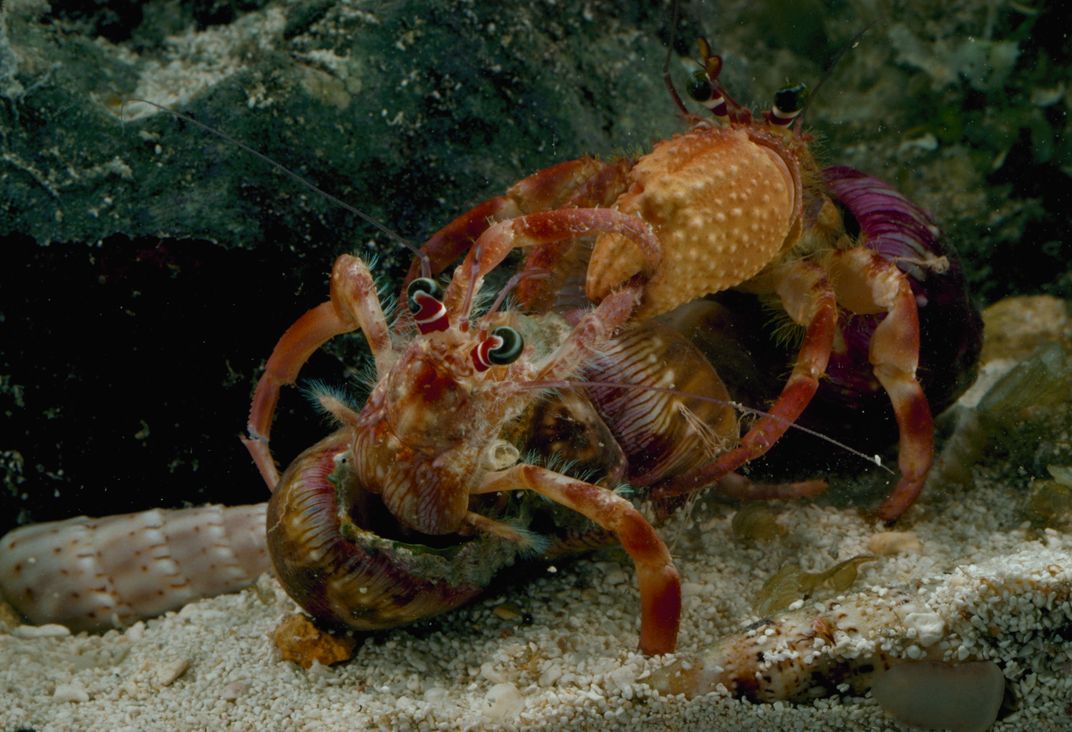Cannibalistic Hermit Crabs Salivate at the Smell of Their Dead
Instead of responding to the smell of a relative’s death as the sign that a predator could be about, hermit crabs interpret this cue as fresh dinner
/https://tf-cmsv2-smithsonianmag-media.s3.amazonaws.com/filer/0f/4d/0f4d9082-a6ca-4549-81cc-03c23ee9263b/crabface.jpg)
In the animal kingdom, cannibalism isn’t taboo. Snacking on dead members of the same species is widespread among creatures ranging from orangutans to octopuses.
Hermit crabs, too, are no strangers to this practice. These crustaceans pick at their dead with mini pinchers and gain nutritional benefits from consuming the flesh of former neighbors.
In the hermit crab world, however, a conundrum exists: where there is a dead hermit crab, there very likely could be a crab-killing predator about. So how do hermit crabs balance the reward-versus-risk of scuttling over to the site of a recent kill for a quick meal while ensuring that they don’t run into a hungry predator still lurking about?
Mark Tran, a zoologist at Michigan State University, decided to create a series of macabre experiments to find out, which he describes in the Journal of Experimental Marine Biology and Ecology.
“I actually stumbled upon the cannibalistic behaviors while trying to use the scent of dead [hermit crabs of the same species] as an aversive conditioning clue,” Tran explained in an email. Perplexed by the crabs’ unexpected reaction—they seemed excited rather than fearful of the smell of death—he reached out to another hermit crab expert, Brian Hazlett of the University of Michigan. “He responded that he had never observed these cannibalistic behaviors in any other hermit crab species, so I ran with the project,” Tran said.
Tran purchased wild-caught members of two different hermit crab species, Clibanarius digueti and Paguristes perrieri. Both of these species reside in the Gulf of California and frequently live together in big crab clusters. After acclimating the hermit crabs to a laboratory aquarium, he randomly chose one medium-sized male crab from either species to sacrifice for science each day. He pulled the animals form their shells and euthanized them with “one swift, crushing blow from the blunt end of a glass pipette.” (Tran adds that every attempt was made to limit the crabs’ pain and suffering.) Then, he macerated then victim and filtered its pulpy remains into the still-living crabs’ tank.
When the smell of hermit crab death hit the water, the other crabs immediately responded with enthusiastic foraging behaviors, regardless of whether the dead crab was of the same species or the other one. The smell of mortally injured relatives, in other words, whet the hermit crabs’ appetites rather than caused them to recoil into their shells for protection from a phantom predator.
In a second experiment, Tran attempted to call the hermit crabs’ bluff. If given the chance, would they, in fact, rush to the kill site of a relative and eat it? In 80 trials, he randomly selected another male individual, and killed it as before—but without the maceration. Then, Tran randomly selected another healthy crab from the tank, and placed it into an isolated enclosure with the freshly killed one. For ten minutes, he watched the scene play out, recording whether the living crab approached the food item and ate it, and the total time it spent feeding.
Almost without fail, the living hermit crabs did not hesitate to eat the dead ones, Tran found, regardless of whether they were of the same species or not. Only one single individual was the sole voice of anti-cannibalism morality. That crab retracted into its shell when presented with the dead member of its own species. However, Tran points out, that could have just been because the crab was startled.
Tran also found, on the other hand, that the hermit crabs were slightly quicker to approach dead crabs of different species, and that they also spent more time eating those less-related crabs. Hermit crabs, in other words, seem to be able to tell whether or not they’re eating a member of their own species. Although they don’t let that distinction stop them, they do have a slight preference for less-genetically related sources of food.

The shell-bound scavengers, Tran thinks, have evolved to recognize the smell of dead comrades as a source of food rather than danger. This makes sense, given that these animals live in large groups and frequently engage in crab-on-crab combat over shells and other resources. Therefore, a dead crab is most likely to represent a casualty at the claws of another murderous crustacean rather than one taken out by a much more dangerous octopus, fish or bird predator.
“Not a lot of work has been done regarding the foraging behaviors of hermit crabs,” Tran says, “so seeing that they have evolved specific behaviors mediating cannibalism is particularly interesting.”
/https://tf-cmsv2-smithsonianmag-media.s3.amazonaws.com/accounts/headshot/Rachel-Nuwer-240.jpg)
/https://tf-cmsv2-smithsonianmag-media.s3.amazonaws.com/accounts/headshot/Rachel-Nuwer-240.jpg)